#oregon hops and brewing archives
Explore tagged Tumblr posts
Text
Intern report: processing the Pete Dunlop collection
Emporia State University grad student Alyssa Collins finished up her work on the Pete Dunlop Collection last week. We had a great plan for her to dig in to the physical collections during her 4 month practicum with us, but obviously that all changed 8 weeks ago when we all came home. I am delighted that we were able to find meaningful electronic collections for her to work on!
This is also a cool collection because it includes both Dunlop’s research files for the book, but also a crawl of his blog.
Pete Dunlop Collection, 1903-2010
Pete Dunlop wrote the book Portland Beer: Crafting the Road to Beervana and writes the blog Beervana Buzz, which focuses on craft beers in Oregon. He has donated his collection of research papers that he used to help him write his book, which focuses on history and tries to educate the novice on Oregon brewing, whereas his blog is about events, life, and beer. It is interesting to read his book and then read his blog. You can see how times are different and how his opinion has evolved as the industry changed. It is awesome that we got an Internet Archive web-crawl done on his blog because it really captures an opinion of the beer industry. Recently, with Covid-19 his blog has not been as active as they once were. He does express concern over the changes happening to the craft brew industry and how flooded the market is.
As another perspective, I do think it is interesting that the beer industry is changing. We are seeing more variety of drinks, such as seltzers (which Dunlop has a strong opinion about in his blog if you wish to read), and a flooding of different styles of beers. Another concern he has is how craft breweries are going to survive after this is over.
In the past breweries have come and gone. Some have merged with larger corporations and some have sold off and been closed by others. It is a changing environment in Oregon when it comes to beer. Even now, as Covid-19 is shutting down so many businesses Oregon’s craft breweries are striving to be essential by adapting to demand. Some craft breweries are still brewing to attract attention during this time, such as Old Town Brewing creating a new IPA that they can and deliver directly to Portlanders.
Working on this project was interesting because I really got to see how Portland, Oregon has changed over time when it comes to beer. It really made me pay more attention to the craft brewery industry in Oregon, especially in recent events. I am now seeing how the industry is all over Oregon, there are breweries in even small communities on the Oregon coast! It is amazing to see how much variety we have in this state. We are rich with micro brews.
Below is a series of photos of the back-end of things. Right now, due to everything, I am working with digital collections in a shared file on Box. This has added a new spin on things as we try to continue to process collections while staying safe.

In this photo you see the series broken down into four areas. There are five series total, but since the fifth series is the blog it isn’t included in Box.

Upon clicking on Series 3 this is how the files are broken down. Since this is a collection of newspaper articles that Dunlop used for his research they are broken down by dates.

When you open one of the files you get the collection of newspaper articles. I don’t know about those of you reading this but I love old newspapers. There is something that is fascinating with how they advertised and what they focused on at the time. People talk about sensational journalism now but when you read some of the stories in older newspapers you can’t help but giggle over what some of the articles focused on.

This is an unpublished photo that Dunlop took to show the changes of the Burnside St. near the Weinhard’s Brewery. The top image is from 1956 during the 100th anniversary. The bottom photo was taken by Dunlop in 2013. In just 57 years the street looks different in many ways. It is a testament to how much Portland is changing every year. It is a growing city that changes and adapts with the times, or tries to do its best considering how quickly it has grown. It makes sense that Dunlop would focus his book on the Portland area, with its growing craft breweries and just a changing city landscape. His blog really shows how the city and beer has changed in the short amount of time since his book was published. Pete Dunlop’s papers are now available for you to view and they are very interesting. Also check out his blog!
#pete dunlop#Portland Beer: Crafting the Road to Beervana#electronic records#oregon hops and brewing archives#oregon beer#beer history
4 notes
·
View notes
Photo
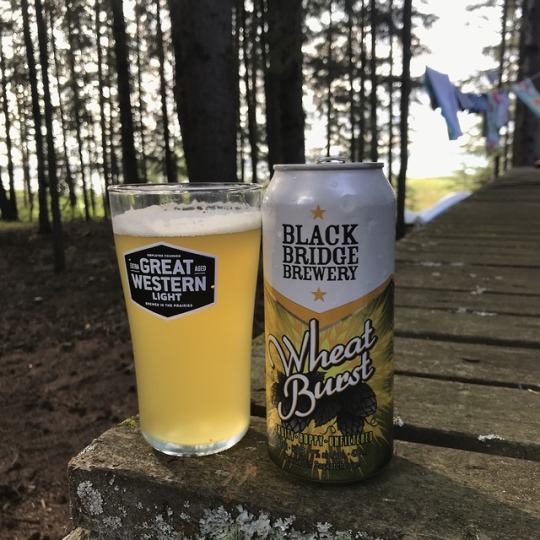

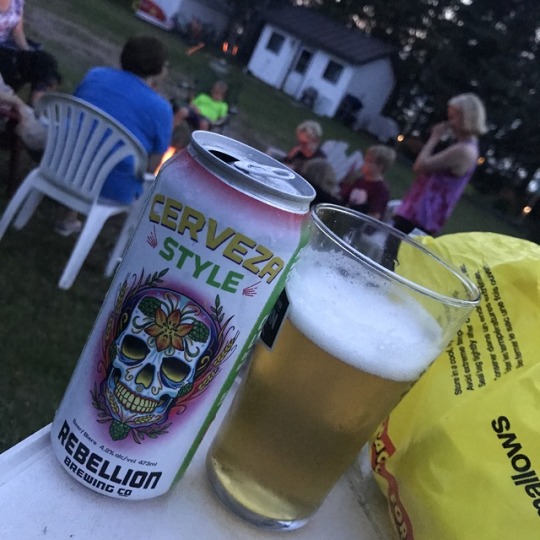
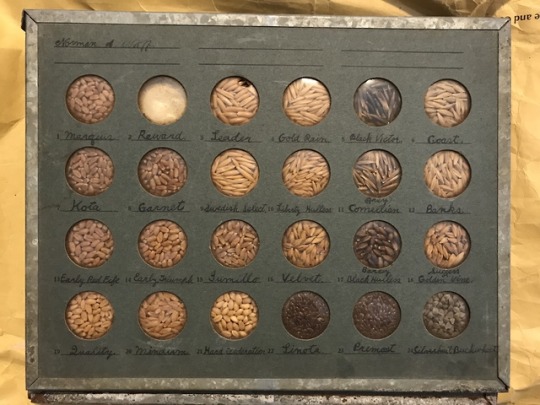
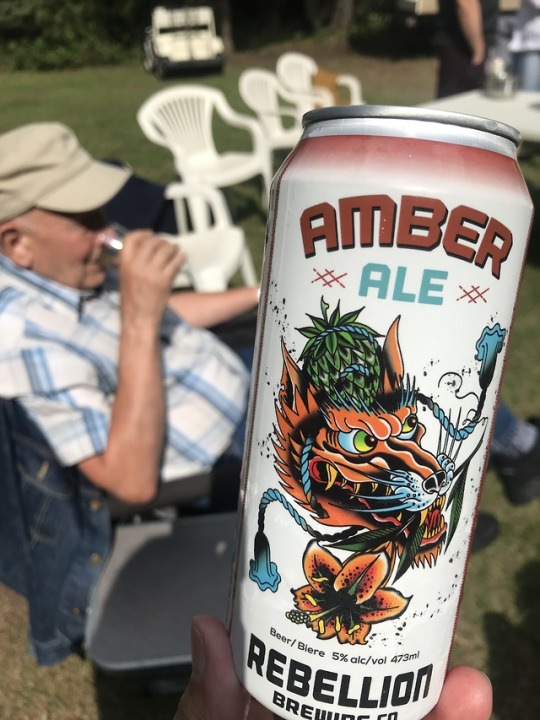
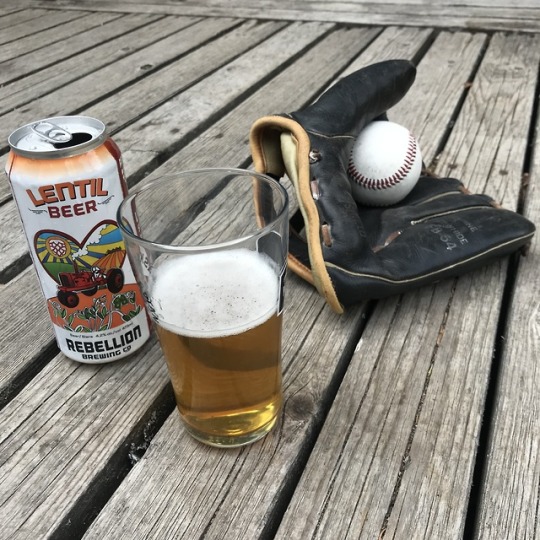
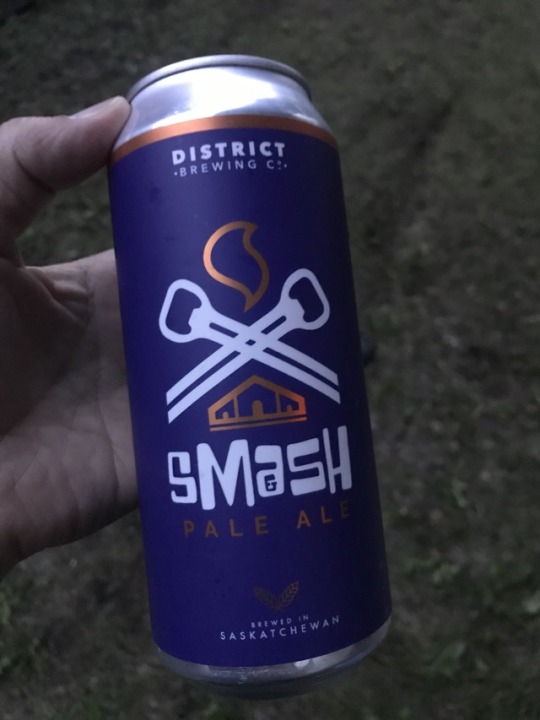

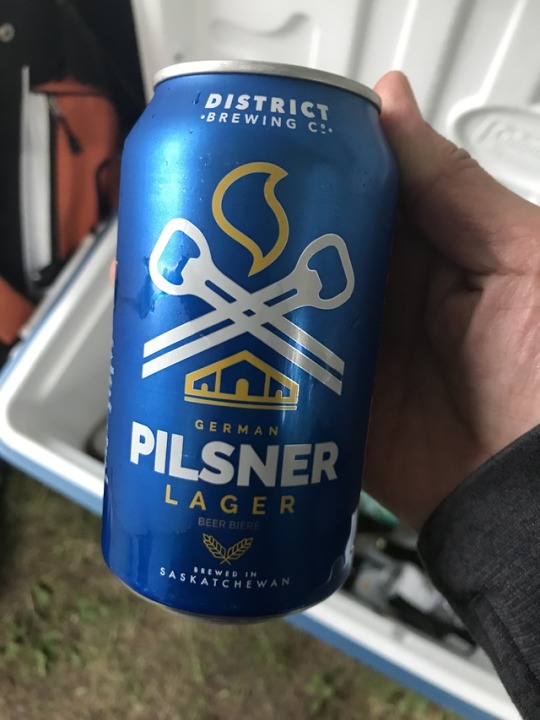
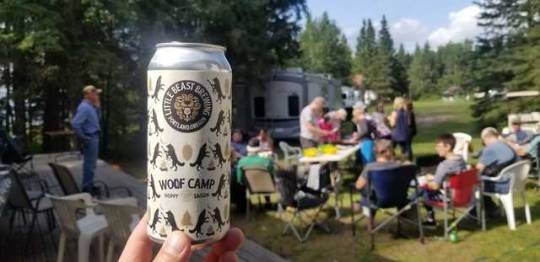
Drinking Beer in Saskatchewan: Part II
When family reunions come up, just get your shit done and go. Did I need my cousin to remind me of this, and tell me he might spend the better part of the week curating the beer menu? No, but it was the kick in the arse I needed when feeling a little overwhelmed with work deadlines.
The sampling of Saskatchewan beer I tried over the weekend made me realize it’s time to hit the road for some cross country beer adventures. We know more good beer is out there, and while there are still barriers to inter-provincial liquor trade, we must go to it.
District Brewing (Regina). SMaSH pale ale, German Pilsner, and Bavarian Dark lager. Did I also try the Märzen? Likely.
Paddock Wood Brewing (Saskatoon). Yakima West Coast IPA. West coast hops tasted pretty good with the breeze off Brightsand lake. SK’s first mircobrewery still going strong.
Rebellion Brewing Co (Regina). Cerveza (paired surprisingly well with marshmallow), Amber ale, and their smooth and unique Lentil beer.
Black Ridge Brewery (Swift Current). Flagship beers IPA, Wheat Burst, and their malty Milk Stout. Beer born in wide open spaces, indeed.
And yes, Little Beast’s Woof [sic] Camp saison and Fort George’s 3-way IPA collaboration with Ruse and Cloudburst are from Oregon, and represented the Portland Wooffs who could not be there. Along with a sampling of BC’s Yellow Dog, Dageraad and Four Winds that travelled safely in my suitcase, it was an all around perfect family/beer reunion. Blair, thanks again dear cousin of beer, let’s raise a glass together again soon.
#turtleford#saskatchewan#skcraftbeer#district brewing#paddock wood brewing#rebellion brewing#black ridge brewing
5 notes
·
View notes
Text
Join Ecliptic Brewing Company, October 19th, in celebration of their latest anniversary.
Press Release
Portland, Oregon. Earth. (October 8, 2019)- Oregon beer icon John Harris’ Ecliptic Brewing is about to complete its sixth orbit around the sun. To celebrate, the company is hosting a free party at the brewery on October 19th, with donations accepted to benefit the Jeremy Wilson Foundation. Additionally, Ecliptic will release its Sixth Orbit: Hazy Plum IPA at the party.
Says Ecliptic Owner and Brewmaster, John Harris, “I can’t believe it’s time to celebrate another anniversary! We are so excited to host Jeremy Wilson at the party and support his foundation again.” In regards to the latest beer in Ecliptic’s lineup, Hazy Plum IPA, Harris says he’d been experimenting with different fruits back in February and loved the contribution of plums to the ever-popular hazy IPA style. “Plums are a stone fruit, so they add a nice, subtle flavor, and we chose hops that will meld well with them, like Amarillo, Citra and Sabro.” The first keg of Hazy Plum IPA will be tapped at the party, and to-go bottles will be available for purchase.
Ecliptic’s Sixth Orbit Anniversary Party will feature multiple live band performances beginning at 6pm, with the Eyelids headlining. Harris will be leading brewery tours throughout the day, and Ecliptic’s chefs are offering free tastes in the restaurant and special rare beers from the company’s archives. Additionally, Ecliptic will be matching any donations to the Jeremy Wilson Foundation.
About Ecliptic Brewing’s Sixth Orbit Anniversary Party When: October 19, 2019: 11AM-10PM. Music begins at 6PM. Tours offered on the hour from 12PM-4PM. Where: Ecliptic Brewing, 825 N. Cook Street What: A birthday party for Ecliptic Brewing, celebrating six years of business, with live outdoor music, rare beer tappings, tours with John Harris, and free food tastings. Cost: FREE, with donations accepted at the door to benefit The Jeremy Wilson Foundation. Ecliptic will also be matching these donations!
Band lineup:
· Jeremy Wilson: 6-6:30PM · Little Sue featuring Paul Brainard & Dave Lipkind: 6:45-7:30PM · Braille Stars: 7:45-8:30PM · Eyelids: 8:45-10PM
…
For up to date details on the event, visit the Facebook page here. About Sixth Orbit: Hazy Plum IPA Ecliptic Brewing’s sixth orbit around the sun is October 20th. We brew a different beer each year to celebrate. Sixth Orbit uses real plums along with Amarillo, Chinook, Columbus, Citra, Sabro, BRU-1 and Brewers Gold hops. ABV 8.5% IBU 60
…
About Ecliptic Brewing Ecliptic Brewing is a venture from John Harris, an Oregon beer icon whose background is steeped in the state’s rich craft brewing history. The name Ecliptic unites Harris’ two passions: brewing and astronomy. As such, the brewery celebrates the Earth’s yearly journey around the sun through both its beer and restaurant menus. Harris’ signature beers include Starburst IPA, Phaser Hazy IPA, Carina Peach Sour Ale and Capella Porter. For more information, visit: eclipticbrewing.com.
Ecliptic beers are available at the brewery (825 North Cook St), in bottle and on-tap throughout the area, and distributed by: Maletis Beverage (Portland, Salem, Vancouver WA), Bigfoot Beverage (Eugene, Bend, Coast), Fort George Distributing (Northern Oregon Coast, Southern Washington Coast), Hodgen Distributing (Eastern Oregon), Summit Distribution (Southern Oregon), NW Beverages (Seattle, Tacoma), Odom (Eastern Washington, Northern ID), Dickerson Distributing (Bellingham), Crooked Stave Artisans (Colorado), Freedom Distributors (North Carolina), Beer Thirst (Canada) and Tread Water (Japan).
###
from Northwest Beer Guide - News - The Northwest Beer Guide http://bit.ly/2AYhGF2
2 notes
·
View notes
Text
rival-the-rose replied to your post: I’ve been hired! For a people job! By official...
why are they archiving beer. that stuff doesn’t actually get better w/ age
it’s mostly brewing techniques, hops, and history of brewing in Oregon. but a library full of beer barrels is a beautiful picture
1 note
·
View note
Text
The Boston Area Is Getting Beer Gardens Galore
And other Boston-area beer and liquor news, updated weekly
As the Massachusetts beer scene continues its fast-paced growth, we’re tracking beer-related news bites right here: brewery openings and closures, links to interesting features from other publications, and more. We’re throwing in some liquor news for good measure, too. This piece is updated most Thursdays, and the most recent additions are at the top. Email [email protected] with any Massachusetts beer or liquor news that should be on our radar.
Check out our 2017 archive of beer news here, and for a more in-depth look at the scene, check out the archive of our Beer & Mortar feature series.
April 26, 2018
ALLSTON, BOSTON — Aeronaut will once again host a pop-up beer garden in Allston this summer at Zone 3 on Western Avenue. Expect live music, plenty of beer, and a family-friendly, dog-friendly vibe every Wednesday and Friday evening from June through September. (The Somerville brewery is also reportedly considering a bike-friendly summer pop-up elsewhere in the Boston area this summer; stay tuned.)
BEER STORES EVERYWHERE — For the Boston Globe Magazine, Devra First writes “an open letter to men who sell beer, from a woman who drinks it,” asking those who sell beer to realize that a customer’s gender doesn’t indicate anything definitive about that customer’s beer knowledge, likes, or dislikes. In other words, don’t assume that women shopping for beer only want fruit beer or cider recommendations.
CAMBRIDGEPORT, CAMBRIDGE — Starting May 6, the Central Flea market will be back up and running on Sundays, this time at University Park near Massachusetts Avenue. Cambridge’s Lamplighter Brewing Co. will run an eight-tap beer garden there (and there will also be food trucks around) from 11 a.m. to 5 p.m. each week, weather permitting. Aside from a variety of Lamplighter styles, the brewery also wants to serve a local cider. The space will fit about 100 people, and there will be some long tables and benches, standing tables, and plenty of open grassy space.
DOWNTOWN BOSTON — More outdoor drinking? More outdoor drinking. The next installment of seasonal outdoor extravaganza Boston Seasons, this one dubbed the Patios and running through spring and summer, will debut at City Hall Plaza on May 4, featuring a Wachusett Brewing Company beer garden (as well as Cambridge’s Honeycomb Creamery, serving ice cream). The beer garden will be pouring pints (of Wachusett as well as some guest brewers) starting at 4 p.m. on weekdays and 11 a.m. on weekends. Keep an eye out for pop-ups and activities throughout the season, including puppy visits, Boston Public Market picnic events, mini golf, and more.
Also downtown, the aforementioned planned “Dewey Square Drinkery” pop-up bar proposed by the Greenway Conservancy now has a vendor attached: Downeast Cider, as Boston Magazine reports. Pending permitting, the Downeast Back Porch on the Greenway, as it’ll be called, will be steps from South Station, serving five ciders on draft, including a new mint lemonade flavor that’ll be exclusive to this pop-up. Also on the menu: wines from Half Bottle Cans and a rotating local beer. The Back Porch will be open from late May through October on Monday, Wednesday, and Friday evenings, as well as on the weekends. As usual, there will be food trucks in the area. Expect lawn games, live music, and other attractions.
Also also downtown, and also by the Greenway Conservancy, the seasonal beer garden near Rowes Wharf will probably come back again this summer — stay tuned for an announcement soon — and signs point to Trillium reprising its role there.
ROXBURY — The opening of the Backlash Beer brewery and taproom in Roxbury is so close; it could debut in mid-May. The brewery will go into its final inspections in the coming weeks.
April 19, 2018
Rachel Leah Blumenthal/Eater
Part of Underground at Ink Block, which could soon be home to a Castle Island Brewing seasonal beer garden
ALLSTON, BOSTON AND BEVERLY — Heading to a Boston Cannons lacrosse game at Harvard Stadium or Endicott College this season? The team will be running a craft beer garden for the home games at both stadiums this year, featuring Bent Water Brewing Company, True North Ales, Jack’s Abby, and Castle Island Brewing Company, with Bent Water and Castle Island also brewing exclusive Cannons-themed beers for the occasion.
CINCINNATI — With Boston Beer Company busy breaking in its relatively new taproom at its Jamaica Plain facility and planning to expand to Downtown Boston, it’s also busy out of state: It’ll open a 9,000-square-foot taproom across the street from its existing Cincinnati, Ohio brewing space, which it has owned since 1997.
EVERYWHERE — Salem’sNotch Brewing has teamed up with the Trustees, the non-profit conservation group that oversees more than 46,000 acres of Massachusetts land (over 25,000 of those acres are publicly accessible) — from parks and gardens to hiking trails and lighthouses. This partnership will allow Notch to pop up at a variety of Trustees sites with a mobile beer garden. Most events will be free, and many will include live music and other family-friendly activities to be enjoyed while the adults drink Notch’s low-ABV ales and lagers. Keep an eye on the event calendar here.
IPSWICH — Haven’t yet made it to the new tasting room at Privateer Rum (11 Brady Dr.)? Northshore Magazine features a nice peek inside the attractive space; take a look, and then go taste rum at the boat-shaped bar.
SOUTH END, BOSTON — Castle Island Brewing, which has a taproom in Norwood, plans to open a seasonal beer garden in Boston’s South End at Underground at Ink Block (90 Traveler St.), pending city approval. The art-covered park debuted last year under I-93, and Castle Island Brewing’s 5,000-square-foot beer garden (“Castle Island at Underground”), if approved, will open there on May 11 and last through mid-October, operating from 3 p.m. to 10 p.m. on Thursdays and Fridays and 11 a.m. to 10 p.m. on Saturdays and Sundays. There will be about eight different beer styles available each day, as well as a couple wines. Thanks to some new equipment in Norwood, Castle Island has been able to increase production and play around with some new small-batch experiments, which will make appearances Underground. The spacious beer garden will fit around 400 people, and there will be lawn games and probably food trucks and other vendors onsite. The beer garden is slated to appear seasonally for at least five years.
March 29, 2018
Down the Road Beer Co./Facebook
Down the Road Beer Co.’s Goopmassta Session IPA, which the state wouldn’t allow to be infused with CBD
ASHLAND — Medfield-based, athlete-founded Zelus Beer Company — which produces “hydration-friendly” beers that are “crafted for your active lifestyle,” with low alcohol content — will open a pop-up taproom and beer garden at the Corner Spot in Ashland (6 Cherry St.) from April 13 to April 26, offering tasters, pints, and merch. There will also be a food truck onsite, as well as music and other events. Keep an eye on the Zelus website for scheduling information and updates.
EVERETT — With retail cannabis sales set to begin on July 1, one local brewery was hoping to be the first in the state to infuse beer with CBD, an active compound in cannabis that is thought to have some potential medical benefits without the psychoactive effects caused by another well-known cannabis compound, THC. Down the Road Beer Co. (199 Ashland St.) hoped to add CBD to its newly released Goopmassta Session IPA, but the state’s Alcoholic Beverages Control Commission said no: “Infusing or otherwise adding cannabinoid extract in alcoholic beverages is considered adulteration of alcohol,” which is a no-no. (Industrial hemp, however, is allowed in the manufacture of alcohol in Massachusetts under certain conditions.) Want to try CBD-infused beer? Head to Vermont and seek out Long Trail Brewing’s Medicator. In Oregon, Coalition Brewing is also making a CBD-infused beer, Two Flowers IPA.
HARVARD — Carlson Orchards (115 Oak Hill Rd.), which has been producing non-alcoholic apple cider for decades, is getting into the hard cider game, the company announced this week, thanks in part to some consultation with the Stormalong Cider team — neighbors at New England Apple Products in Leominster, where Carlson Orchards’ non-alcoholic cider is produced. “We wanted to produce a hard cider that was similar to our premium farmstand cider and ultimately decided to make an ‘unfiltered’ hard cider for increased apple taste and character,” said Carlson Orchards president Frank Carlson, via press release. The first off-site release will be 16-ounce cans of Oak Hill Blend, distributed around the state via the Massachusetts Beverage Alliance, available starting April 1. Stay tuned for a potential fall 2018 opening of a tasting room onsite at Carlson Orchards.
MASHPEE — Today, March 29, is opening day for Cape Cod’s Naukabout Brewery & Taproom (13 Lake Ave.), a seven-barrel brewhouse with lake and river views. It’s open from 3 p.m. to 9 p.m. today and 2 p.m. to 9 p.m. this Friday and Saturday (closed on Sunday). The opening lineup of beers includes Quittin’ Time, a “juicy” and “tropical” New England IPA; the triple dry-hopped Tides double IPA; a 3.5%-er, Stormborn Stout; and more.
SOUTH DEERFIELD — Berkshire Brewing Company (12 Railroad St.), which has been around since 1994, could soon open an 850-square-foot taproom that’ll operate a few days a week, with 20 taps, pretzels from Baked in Shelburne Falls, and food trucks outside on summer weekends. (Customers will also be able to bring in their own food.) There will be room for about 55 people inside. Why now? A recent amendment to a state law is now making it possible for the brewery — which has a pub-brewer wholesale license — to move from only offering free samples during tours to actually selling poured beer (but not packaged beer) onsite.
SOUTH END, BOSTON — Heading to the SoWa Open Market to shop and eat? It takes place on Sundays from May 6 to October 28, from 10 a.m. and 4 p.m., and starting at 11 a.m. each week, you can drink some beer, too. The Power Station (540 Harrison Ave.) will become the Beer Barn, courtesy of Craft Collective, serving up a rotating selection of beers and ciders. There’ll also be lawn games, live music, and more.
March 22, 2018
Greater Good Imperial Brewing Company/Facebook
Greater Good Imperial Brewing Company
FALL RIVER — Canned Heat Craft Beer Company (52 Ferry St.) could open as soon as early May; the team plans to can (of course) and distribute the beer, and there will also be tasting hours at the space, which will include cold food and a patio. Canned Heat has been previewing some potential beers on Facebook, including Limesicle, a milkshake IPA made with lime peel and vanilla bean; Aloha Brown, an English-style brown that will be aged on toasted coconut; and a Portuguese-inspired pilsner.
HAMPTON, NEW HAMPSHIRE — Smuttynose Brewing Company (105 Towle Farm Rd.) has been sold for an undisclosed amount to Runnymede Investments, a venture capital and investment firm based in North Hampton, New Hampshire, that intends to help the brand “not only survive, but…thrive.” Former Boston Beer Company executive Rich Lindsay, who was briefly CFO for Night Shift Brewing, will be CEO.
MARLBOROUGH — Walden Woods Brewing(277 Main St.) is so, so close to opening. It was supposed to happen this past weekend, but there were some delays. Look for it within the next few weeks.
ROSLINDALE — Alas, the season is about to end for Trillium’s temporary beer hall at the Roslindale Substation (4228 Washington St.). This Sunday will be the final day; check out some details for the last few events here.
SPRINGFIELD — In a Mass. Brew Bros. blind, bracket-style tasting of 20 Massachusetts New England IPAs, the victor was a nanobrewery in planning, Rustic Brewing Company, with a brew called Hop Blind. Lots of more established breweries were included, such as Trillium, Idle Hands, Tree House, and Lord Hobo. Western Mass. apparently has a lot to look forward to when Rustic opens, focusing on New England IPAs and milkshake IPAs.
WALTHAM — Contract brand Mighty Squirrel Brewing Co. will get its own permanent home later this year, likely around fall — a 23,000-square-foot brewery and taproom right by Beaver Brook Reservation (411 Waverley Oaks Rd.). The large space will include a second taproom for overflow and private events, two patios, and a 30-barrel system, as well as an additional five-barrel pilot system for experimentation. The brand launched a few years back with the aim of producing protein-packed post-workout beers, but these days, Mighty Squirrel has moved away from those recipes, instead producing beers such as the hazy Cloud Candy IPA, Mocha Stout milk stout, and Kiwi White Belgian white ale.
WORCESTER — Greater Good Imperial Brewing Company(55 Millbrook St.), which focuses on imperial ales and lagers between 8% and 14% ABV (hence the name), has debuted its 100-person taproom; here’s the schedule for the first couple of weeks. Greater Good’s kitchen, dubbed Toast (stylized “TOAST.”), is serving up five types of grilled cheese, plus soft pretzels, hot dogs, and other snacks.
March 15, 2018
Trillium/Facebook
Trillium’s original Fort Point location
DOWNTOWN BOSTON — At the Royale over the weekend, a number of local bartenders took part in the annual Speed Rack competition, a speed bartending competition by and for women that raises money for breast cancer charities (and visibility for women in the bartending industry). This year, Tainah Soares (of A4cade in Cambridge) was crowned Miss Speed Rack New England, and she’ll go on to compete at the national finals in May, taking place in Chicago.
DOWNTOWN CROSSING, BOSTON — Democracy Brewing(35 Temple St.) — one of several exciting Boston-area brewery openings potentially slated for spring 2018 — is three months into construction and shared some renderings of what it’ll look like when it’s complete. Democracy Brewing is located in the longtime Windsor Button space.
FORT POINT, BOSTON — Trillium Brewing Company’s forthcoming Fort Point location at 47 Farnsworth St. — a move from its original spot in the neighborhood (369 Congress St.) that will result in a much larger and more awesome space — is moving along. BLDUP has a March construction update on the 16,000-square-foot project, noting that a permit has been submitted for restaurant occupancy. The two-story space, which could open by the end of the year, will include a brewpub with a full kitchen and microbrewery, bar on each floor, a room for private events, a retail shop, and two outdoor patios — one of which will be on the roof.
ROSLINDALE, BOSTON — Distraction Brewing Company (2 Belgrade Ave.) has now secured its Massachusetts farmer-brewery license, which lets it produce beer. Still in the works: a pouring license, zoning, and building the taproom.
WEYMOUTH — In addition to Barrel House Z (95 Woodrock Rd.), which opened a year and a half ago, and the forthcoming Article Fifteen (835 Washington St.) (see February 8 update below), Weymouth has even more beer on the way. Vitamin Sea Brewing has signed a lease near Barrel House Z and could open a 10-barrel brewery and taproom by the end of 2018, featuring a patio and rotating food trucks.
March 1, 2018
Greater Good/Facebook
Growlers at Greater Good Imperial Brewing Company, opening soon in Worcester
BOSTON — Prepare for beer gardens. Once the season arrives, Trillium’s popular Greenway garden will likely make a comeback this year, as the Herald reports, and that’s not all: The Greenway Conservancy is trying to find a brewery for “Dewey Square Drinkery,” a pop-up bar that would be open at least a couple days a week in Dewey Square. Stay tuned, and in the meantime, catch Trillium’s other seasonal beer garden — an indoor one — at the Roslindale Substation (4228 Washington St.)
CAMBRIDGE TO MEXICO CITY — Moe Isaza, bar manager atPammy’s(928 Massachusetts Ave., Cambridge), is currently competing for his third time in the annual Bacardi Legacy Cocktail Competition, and he’s already made it quite far — he’ll be one of just two United States finalists competing globally in Mexico City against about 30 international bartenders on April 25. The US finalists were pulled from a field of 720 recipes submissions, narrowed down through several stages of judging and competition. Isaza’s drink is called the Poderoso and includes Bacardi Ocho, coffee liqueur (paying homage to Colombia, where Isaza was born before coming to East Boston as a four-year-old), pineapple juice, amaro, and a muddled lemon wedge.
EVERETT TO PAWTUCKET AND BEYOND — Night Shift Brewing (87 Santilli Hwy., Everett) is outgrowing its home and is now doing some contract brewing out of the Isle Brewers Guild cooperative in Pawtucket, Rhode Island, adding about 10,000 barrels a year to Night Shift’s output. And it’s the Everett brewery’s first foray into Rhode Island; it doesn’t yet distribute there, but its beers made at Isle Brewers Guild will be on tap and in cans at the Guild taproom.
In other Night Shift news, Braintree’s Widowmaker Brewing(220 Wood Rd.) has signed on with Night Shift Distributing (Night Shift Brewing’s sibling distribution arm) to take things to the next level (previously self-distributing to around 30 nearby accounts), hoping to spread around the whole Greater Boston area, not just the South Shore. Keep an eye out for Widowmaker’s Ecstasy of Gold American IPA and 50 Year Storm Double IPA around town, likely followed soon by the Donut Shop Stout.
And in other Night Shift news, Night Shift Distributing recently brought its first gluten-free brewery into its portfolio, Ghostfish Brewing out of Seattle. Four-packs began to hit Massachusetts shelves a couple weeks ago; look for Ghostfish’s Grapefruit IPA, Meteor Shower Blonde Ale, and Shrouded Summit Belgian White Ale.
IPSWICH — Privateer Rum (11 Brady Dr.) announced today that Maggie Campbell — head distiller since 2012, vice president since 2015 — has risen through the ranks again. She’s now president of the company, working alongside founder and CEO Andrew Cabot to further grow the seven-year-old brand, including doubling Privateer’s production capacity this year. (Privateer also recently debuted a new tasting room at the distillery.) Campbell is a familiar and distinguished face in the distilling world (and wine world, too), appearing on a number of boards and committees, as well as winning plenty of awards and recognition for her work at Privateer.
MALDEN — In case you missed yesterday’s news, Malden is getting lots more beer.
WORCESTER — Here’s a sneak peek inside Greater Good Imperial Brewing Company(55 Millbrook St.), set to open later this month with a focus on hefty imperial brews. The 100-person taproom will also have live music, games, and some food, such as panini and pretzels.
February 23, 2018
American Fresh/Facebook
American Fresh Assembly Row patio
SOMERVILLE — Somerville Brewing Company, aka Slumbrew, will be temporarily bringing back its outdoor beer garden at Assembly Row. “We’ll be back this summer with outdoor drinking and dining right at Assembly Row,” said cofounder Caitlin Jewell in a Facebook live video today. “We have bands and bocce and fun.” The beer garden, which was open in warmer seasons and covered up by a tent in colder seasons, was around for nearly three years before shutting down in fall 2017. A couple months later, Somerville Brewing Company opened up a full-service restaurant and bar, American Fresh Brewhouse, just down the block at 490 Foley St. in Assembly Row. Plus, there’s also the original Somerville Brewing location, a brewery and taproom in Somerville’s Boynton Yards neighborhood, right by Union Square (15 Ward St.)
In a Facebook thread, Jewell mentioned that this time around the beer garden will have “no tent, just fresh air.” She also noted that the “current plan” is that it’s just coming back for this upcoming warm season; the land is still slated to be built upon — part of Assembly Row’s seemingly never-ending development — but plans got delayed by a year.
Another beer update elsewhere in Somerville: On March 3, Winter Hill Brewing Co.(328 Broadway, Winter Hill, Somerville)will introduce its new milk stout, Large Iced Regular. The name — and the winter release date — is an homage to New Englanders’ year-round iced coffee obsession, and the stout is infused with Counter Culture Hologram coffee. In honor of the release, the brewery will be serving a special Union Square Donuts doughnut on March 3, while supplies last; the doughnut glaze is made using the beer.
February 16, 2018
Pretty Things [official photo]
Pretty Things’ Fluffy White Rabbits
BOSTON — Boston Beer Co., which is behind Samuel Adams beer as well as Angry Orchard hard cider, Twisted Tea, and other alcoholic beverages, has a new president: Dave Burwick, who will leave his position of CEO of Peet’s Coffee for the job. He’s also been a member of Boston Beer Co.’s board of directors for over a decade. Burwick succeeds longtime president and CEO Martin Roper. Meanwhile, Boston Beer Co. founder and chairman Jim Koch will continue to hold those positions.
EVERYWHERE — In honor of International Women’s Day on March 8, female brewers nationwide — including plenty in Massachusetts — will be brewing beers made with a special Pink Boots blend of hops, named for the Pink Boots organization, which supports women in beer-related careers. (Sales of the hops go to the organization.) Keep an eye out for all the Pink Boots beers appearing at breweries around town later this year.
THE UK — At last, the news that Pretty Things’ rabid Boston fanbase has been waiting for! Well, not exactly. Pretty Things founders Dann and Martha Holley-Paquette have a new brewery project in the works, but it’s all the way overseas in Sheffield, England. The popular Somerville-based Pretty Things Beer & Ale Project ended in late 2015 after a seven-year run; the website, which is still live, describes it as “now an ex-project.”
“We always intended to end it on our terms, and we are happy to have done so,” the duo wrote on their website. “That’s why it was a project!”
The new project will be a microbrewery on the site of the Old Dairy, which, as its name suggests, was once a milk and cheese processing plant. The Holley-Paquettes will reportedly “produce craft beer in bottles and kegs for sale to wholesale customers.”
February 8, 2018
Trillium Brewing Company [official photo]
BOSTON / CANTON — No, a Trillium Brewing Company (369 Congress St., Boston; 110 Shawmut Rd., Canton)truck didn’t get “Storrowed�� — that was just a fun bit of Photoshop in order to promote the brewery’s new release, a double IPA called Storrowed. The company describes it as having a “dank nose of sweaty pineapple, mangosteen, and stone fruit [and] intensely juicy flavors of overripe mango, pear flesh, notes of grapefruit pith, and a background hit of raw sugar.” For those who don’t understand the term “Storrowed,” just heed the road signs that prohibit trucks from driving on Storrow Drive. Don’t be that truck that gets stuck at the overpass. You will get stuck.
CAMBRIDGE — Lamplighter Brewing Company (284 Broadway) officially debuts its new back taproom today, February 9, doubling the brewery’s capacity and allowing it to host more private and public events. And it’s got a really great mural.
HAMPTON, NEW HAMPSHIRE — Smuttynose Brewing Company (105 Towle Farm Rd.), which has been a big name in New England’s craft beer world for more than two decades, is for sale. In a note shared by owners Peter Egelston and Joanne Francis on social media and the Smuttynose website, the duo writes: “At this time, in order for our company to continue on the path we embarked on back in 1994, Smuttynose needs someone who can provide financial resources that will move the company forward…We’re strongly committed to making sure this transition is as smooth as possible, and to help the company’s new owner or partner embark on a successful next chapter for Smuttynose and its wonderful staff. We want to emphasize Smuttynose Brewing company is open, brewing our fine beers daily and serving delicious food at Hayseed Restaurant. Many of you have asked how you can help…keep drinking Smuttynose brews and send your rich aunt or uncle our way!”
ROSLINDALE — Distraction Brewing Company (2 Belgrade Ave.) is a big step closer to opening; the brewery has secured its TTB license, meaning that the federal government recognizes it as a brewery. “In other words, we’re one step closer to transforming this raw, beautiful space into a place where our fellow Rozzidents can kick back and enjoy our beer,” the brewery wrote on Facebook late last month. “Still plenty of work to do. But we can’t wait to get our hands dirty.”
WEYMOUTH — There’s a Kickstarter campaign underway to help fund the building of an “epic taproom” for Article Fifteen Brewing (835 Washington St.), a “veteran-owned nano-brewery” that is currently in the buildout phase. The campaign ends in 10 days, and there’s about $4000 left to raise by then. The team has a lease, brewing equipment, and funds to help with the buildout but is seeking a little bit of help to get to the next step of the process. When Article Fifteen opens, it’ll serve beer “inspired by a love of hops and a proud tradition of military, fire, and medical service.”
WORCESTER — Founded in 2014, 3cross Brewing Company (4 Knowlton Ave.) made a change recently: It’s now 3cross Fermentation Cooperative. As the name suggests, it’s now a coop, owned by workers and customers (the first community-owned brewery in the state), and it’s expanding its focus beyond beer to other fermented products.
0 notes
Text
How beer could help with weight loss
A compound found in hops may actually help reverse that beer belly. (iStock)
When it comes to health benefits and alcohol, antioxidant-rich red wine is usually the drink drawing all the praise.
But beer carbs and calories notwithstanding also has its upsides, with studies showing the beverage can help prevent kidney stones, strengthen bones, and aid your digestive system.
Related Image
Now, scientists have discovered another health advantage in your brew: A compound called xanthohumol, a flavonoid naturally found in hops, can be a boon for weight loss and may help scientists create a novel approach to addressing obesity. Tests have also shown xanthohumol can lower cholesterol and blood-sugar levels.
No, drinking beer wont help you lose weight. A pint of IPA contains only 0.0757 mg of xanthohumol, says Cristobal Miranda, a research assistant professor with Oregon State Universitys Linus Pauling Institute and lead author of the study, published in a special issue of Archives of Biochemistry and Biophysics.
To derive any benefits of xanthohumol from beer, youd have to do the impossible and guzzle 3,500 pints per day.
But, researchers say, in the future, a concentrated amount of xanthohumol could be packed into a supplement and taken once a day. The supplement could be a low-cost and effective treatment for metabolic syndrome, the set of factors that increase your risk for heart disease, diabetes, stroke, and other health problems. About one in three Americans have metabolic syndrome, estimates the American Heart Association, so this could be a welcome innovation.
More from Men’s Journal
The 101 Best Beers in America
6 Ways to Lose a Pound of Fat
9 Foods to Avoid Before Sex
The Proven Way to Lose Your Gut
Studies on the health benefits of xanthohumol so far have been carried out in laboratory animals and in cell culture, Miranda says. The results have shown the compound holds promise, potentially reducing risk of cardiovascular disease and type-2 diabetes. Before we know its safety and real efficacy for fighting obesity and more, though, studies will have to be conducted on humans.
For the study, lab mice were fed a high-fat diet and given varying levels of xanthohumol. The rats given the highest dosage of xanthohumol cut their LDL or bad cholesterol by 80 percent and their insulin levels by 42 percent. Their levels of IL-6, a biomarker of inflammation, was reduced by 78 percent. The lab animals were all fed the same rich diet and given the same amounts of food, leading them to gain weight.
But weight gain was 22 percent less in the mice receiving xanthohumol in their diets.
Researchers have long been interested in the health benefits of flavonoids, exploring the compounds found in tea, garlic, chocolate, apples, blueberries, and other foods. Miranda says xanthohumol found in hops is unique because of its potential to address so many health problems, and to do so dramatically.
Xanthohumol is only found in the hop plant, and is not naturally present in any other plant, Miranda says. Any product like beer, hop tea, or a beverage or dietary supplement in which hops, or hop extracts, are used may contain xanthohumol, he says.
For now, we’ll hang tight until we can apply for a human beer-drinking trial.
Source: http://allofbeer.com/2017/09/09/how-beer-could-help-with-weight-loss/
from All of Beer https://allofbeer.wordpress.com/2017/09/09/how-beer-could-help-with-weight-loss/
0 notes
Text
How beer could help with weight loss
A compound found in hops may actually help reverse that beer belly. (iStock)
When it comes to health benefits and alcohol, antioxidant-rich red wine is usually the drink drawing all the praise.
But beer carbs and calories notwithstanding also has its upsides, with studies showing the beverage can help prevent kidney stones, strengthen bones, and aid your digestive system.
Related Image
Now, scientists have discovered another health advantage in your brew: A compound called xanthohumol, a flavonoid naturally found in hops, can be a boon for weight loss and may help scientists create a novel approach to addressing obesity. Tests have also shown xanthohumol can lower cholesterol and blood-sugar levels.
No, drinking beer wont help you lose weight. A pint of IPA contains only 0.0757 mg of xanthohumol, says Cristobal Miranda, a research assistant professor with Oregon State Universitys Linus Pauling Institute and lead author of the study, published in a special issue of Archives of Biochemistry and Biophysics.
To derive any benefits of xanthohumol from beer, youd have to do the impossible and guzzle 3,500 pints per day.
But, researchers say, in the future, a concentrated amount of xanthohumol could be packed into a supplement and taken once a day. The supplement could be a low-cost and effective treatment for metabolic syndrome, the set of factors that increase your risk for heart disease, diabetes, stroke, and other health problems. About one in three Americans have metabolic syndrome, estimates the American Heart Association, so this could be a welcome innovation.
More from Men’s Journal
The 101 Best Beers in America
6 Ways to Lose a Pound of Fat
9 Foods to Avoid Before Sex
The Proven Way to Lose Your Gut
Studies on the health benefits of xanthohumol so far have been carried out in laboratory animals and in cell culture, Miranda says. The results have shown the compound holds promise, potentially reducing risk of cardiovascular disease and type-2 diabetes. Before we know its safety and real efficacy for fighting obesity and more, though, studies will have to be conducted on humans.
For the study, lab mice were fed a high-fat diet and given varying levels of xanthohumol. The rats given the highest dosage of xanthohumol cut their LDL or bad cholesterol by 80 percent and their insulin levels by 42 percent. Their levels of IL-6, a biomarker of inflammation, was reduced by 78 percent. The lab animals were all fed the same rich diet and given the same amounts of food, leading them to gain weight.
But weight gain was 22 percent less in the mice receiving xanthohumol in their diets.
Researchers have long been interested in the health benefits of flavonoids, exploring the compounds found in tea, garlic, chocolate, apples, blueberries, and other foods. Miranda says xanthohumol found in hops is unique because of its potential to address so many health problems, and to do so dramatically.
Xanthohumol is only found in the hop plant, and is not naturally present in any other plant, Miranda says. Any product like beer, hop tea, or a beverage or dietary supplement in which hops, or hop extracts, are used may contain xanthohumol, he says.
For now, we’ll hang tight until we can apply for a human beer-drinking trial.
from All Of Beer http://allofbeer.com/2017/09/09/how-beer-could-help-with-weight-loss/ from All of Beer https://allofbeercom.tumblr.com/post/165144106272
0 notes
Text
How beer could help with weight loss
A compound found in hops may actually help reverse that beer belly. (iStock)
When it comes to health benefits and alcohol, antioxidant-rich red wine is usually the drink drawing all the praise.
But beer carbs and calories notwithstanding also has its upsides, with studies showing the beverage can help prevent kidney stones, strengthen bones, and aid your digestive system.
Related Image
Now, scientists have discovered another health advantage in your brew: A compound called xanthohumol, a flavonoid naturally found in hops, can be a boon for weight loss and may help scientists create a novel approach to addressing obesity. Tests have also shown xanthohumol can lower cholesterol and blood-sugar levels.
No, drinking beer wont help you lose weight. A pint of IPA contains only 0.0757 mg of xanthohumol, says Cristobal Miranda, a research assistant professor with Oregon State Universitys Linus Pauling Institute and lead author of the study, published in a special issue of Archives of Biochemistry and Biophysics.
To derive any benefits of xanthohumol from beer, youd have to do the impossible and guzzle 3,500 pints per day.
But, researchers say, in the future, a concentrated amount of xanthohumol could be packed into a supplement and taken once a day. The supplement could be a low-cost and effective treatment for metabolic syndrome, the set of factors that increase your risk for heart disease, diabetes, stroke, and other health problems. About one in three Americans have metabolic syndrome, estimates the American Heart Association, so this could be a welcome innovation.
More from Men’s Journal
The 101 Best Beers in America
6 Ways to Lose a Pound of Fat
9 Foods to Avoid Before Sex
The Proven Way to Lose Your Gut
Studies on the health benefits of xanthohumol so far have been carried out in laboratory animals and in cell culture, Miranda says. The results have shown the compound holds promise, potentially reducing risk of cardiovascular disease and type-2 diabetes. Before we know its safety and real efficacy for fighting obesity and more, though, studies will have to be conducted on humans.
For the study, lab mice were fed a high-fat diet and given varying levels of xanthohumol. The rats given the highest dosage of xanthohumol cut their LDL or bad cholesterol by 80 percent and their insulin levels by 42 percent. Their levels of IL-6, a biomarker of inflammation, was reduced by 78 percent. The lab animals were all fed the same rich diet and given the same amounts of food, leading them to gain weight.
But weight gain was 22 percent less in the mice receiving xanthohumol in their diets.
Researchers have long been interested in the health benefits of flavonoids, exploring the compounds found in tea, garlic, chocolate, apples, blueberries, and other foods. Miranda says xanthohumol found in hops is unique because of its potential to address so many health problems, and to do so dramatically.
Xanthohumol is only found in the hop plant, and is not naturally present in any other plant, Miranda says. Any product like beer, hop tea, or a beverage or dietary supplement in which hops, or hop extracts, are used may contain xanthohumol, he says.
For now, we’ll hang tight until we can apply for a human beer-drinking trial.
from All Of Beer http://allofbeer.com/2017/09/09/how-beer-could-help-with-weight-loss/
0 notes
Text
How beer could help with weight loss
A compound found in hops may actually help reverse that beer belly. (iStock)
When it comes to health benefits and alcohol, antioxidant-rich red wine is usually the drink drawing all the praise.
But beer carbs and calories notwithstanding also has its upsides, with studies showing the beverage can help prevent kidney stones, strengthen bones, and aid your digestive system.
Related Image
Now, scientists have discovered another health advantage in your brew: A compound called xanthohumol, a flavonoid naturally found in hops, can be a boon for weight loss and may help scientists create a novel approach to addressing obesity. Tests have also shown xanthohumol can lower cholesterol and blood-sugar levels.
No, drinking beer wont help you lose weight. A pint of IPA contains only 0.0757 mg of xanthohumol, says Cristobal Miranda, a research assistant professor with Oregon State Universitys Linus Pauling Institute and lead author of the study, published in a special issue of Archives of Biochemistry and Biophysics.
To derive any benefits of xanthohumol from beer, youd have to do the impossible and guzzle 3,500 pints per day.
But, researchers say, in the future, a concentrated amount of xanthohumol could be packed into a supplement and taken once a day. The supplement could be a low-cost and effective treatment for metabolic syndrome, the set of factors that increase your risk for heart disease, diabetes, stroke, and other health problems. About one in three Americans have metabolic syndrome, estimates the American Heart Association, so this could be a welcome innovation.
More from Men’s Journal
The 101 Best Beers in America
6 Ways to Lose a Pound of Fat
9 Foods to Avoid Before Sex
The Proven Way to Lose Your Gut
Studies on the health benefits of xanthohumol so far have been carried out in laboratory animals and in cell culture, Miranda says. The results have shown the compound holds promise, potentially reducing risk of cardiovascular disease and type-2 diabetes. Before we know its safety and real efficacy for fighting obesity and more, though, studies will have to be conducted on humans.
For the study, lab mice were fed a high-fat diet and given varying levels of xanthohumol. The rats given the highest dosage of xanthohumol cut their LDL or bad cholesterol by 80 percent and their insulin levels by 42 percent. Their levels of IL-6, a biomarker of inflammation, was reduced by 78 percent. The lab animals were all fed the same rich diet and given the same amounts of food, leading them to gain weight.
But weight gain was 22 percent less in the mice receiving xanthohumol in their diets.
Researchers have long been interested in the health benefits of flavonoids, exploring the compounds found in tea, garlic, chocolate, apples, blueberries, and other foods. Miranda says xanthohumol found in hops is unique because of its potential to address so many health problems, and to do so dramatically.
Xanthohumol is only found in the hop plant, and is not naturally present in any other plant, Miranda says. Any product like beer, hop tea, or a beverage or dietary supplement in which hops, or hop extracts, are used may contain xanthohumol, he says.
For now, we’ll hang tight until we can apply for a human beer-drinking trial.
source http://allofbeer.com/2017/09/09/how-beer-could-help-with-weight-loss/ from All of Beer http://allofbeer.blogspot.com/2017/09/how-beer-could-help-with-weight-loss.html
0 notes
Text
Hop into History: Archives and Alcohol in America
Today I gave a talk for the Society of American Archivists conference. Sort of. It was classified as a “social event” and we called it “Hop into History: Archives and Alcohol in America.” It included a presentations by Kira Dietz (cocktail history), Doug Boyd (all things bourbon and oral history), Richard Cox (part of Team Well Crafted North Carolina), Rich Schmidt (Oregon Wine History Archives), and me.
The talk was recorded!
I have a lot of good stories to tell after 7 years of running this archive... But I was selfish and talked about myself. Ot at least selfish and talked about my family.
And hops.
Here’s what I said.
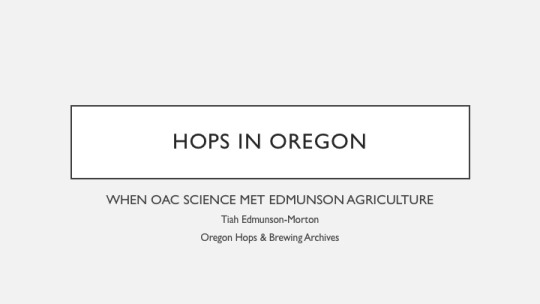
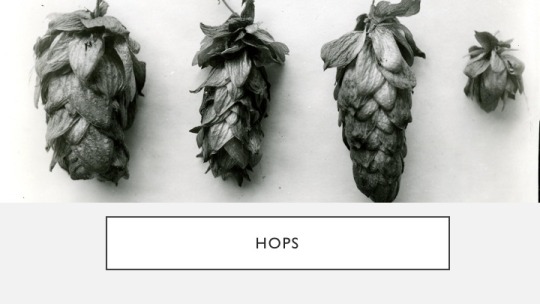
Though early European settlers found native wild hops in nearby woods, by the early 19th century the New England states and New York had dedicated commercial hops growing areas. New York had better soil and proximity to large population centers, and it quickly dominated the other states.
However, soon the hop growing center shifted again to the west coast. Though settlers brought root stock to plant in kitchen gardens and staff grew hops at the Fort Vancouver Farm as early as 1836, west coast commercial hop growing began in earnest in the 1850s. By 1900, both Oregon and California produced more hops than New York. In addition to good soil and weather, early western farmers were helped by the construction of the transcontinental railroad, which allowed them to transport their hops to breweries in the mid-west and east.
And to prompt the question – yes hops were still grown during Prohibition but were primarily grown for export. Oregon, Washington, and California led in hop production, and soon Idaho joined the other three western states. Following WWII, the US was the largest hop producing country in the world, though much of what was produced here was exported.
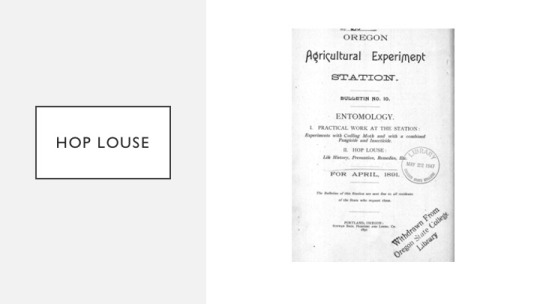
Hop farmers in Oregon faced the problem that plagued other hop-growing states: insects and fungal infections. Research scientists at Oregon Agricultural College had helped farmers with testing and talked about pests or drying since the 1890s; here’s an example of the public sharing of research in an extension station bulletin focused on the hop louse. In 1930 the USDA and OAC formalized a hop research program that would look directly at breeding new varieties and increasing production.
A big issue for farmers at the time was that the hops they were growing (Early and Late Clusters) were meant to grow in England or Europe. They tried growing more mildew tolerant hops like Fuggle, Bullion, or Brewer’s Gold, but still struggled. In 1972, Dr. Alfred Haunold released the Cascade hop, which had been crossed in 1956 and essentially ignored. Other popular modern American hop varieties followed, including Willamette, Nugget, and Sterling.
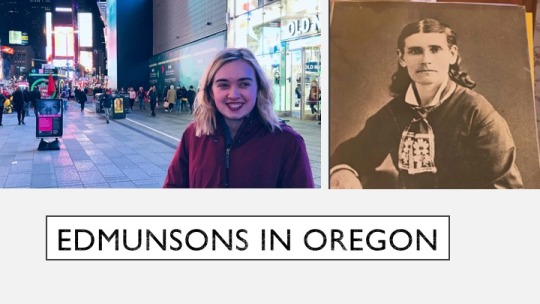
Like hops, my family has also been in Oregon a really long time. My great+ grandma Euphemia Shrum, shown here on the right, came to Oregon in 1846, and her husband John H. Edmunson came in 1850. And in my direct line, my daughter Ella, on the left, is the first to have been born outside of Oregon since Euphemia. I am currently waiting for my niece/nephew to be born in Portland as I speak, so my sister will beat me to the “unbroken line” line!
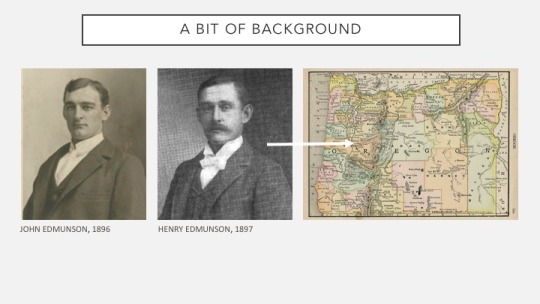
Euphemia’s grandsons, my great-great grandpa Henry Edmunson and his brother John, were farmers, and by 1897 they were trying their hand at hops with a yard planted in Goshen, Oregon. Over the next decade they were quite successful; John was elected chairman of the Lane County Growers Association and their farm activities were reported in local newspapers.
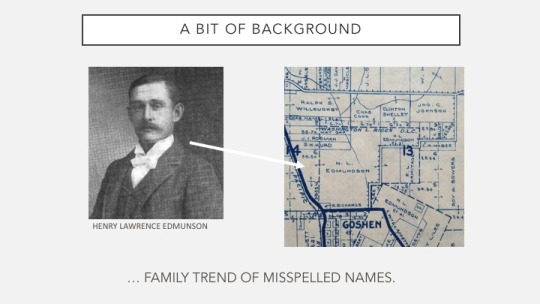
Newspapers and legal documents alike spelled our name wrong���
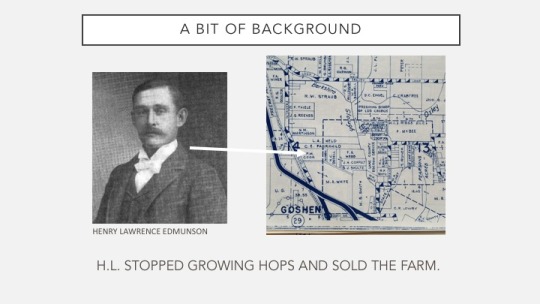
The Edmunsons farmed their land through the late 1950s, but sour cherries had replaced hops after mildew wiped them out in the 1940s.
They were in good company. In 1900, there were roughly 250 growers in Oregon, a number that ballooned to 2,000 in 1914 and earned Oregon the distinction of being the nation's largest producer. By 1930, there were 14,000 acres harvested in Oregon and the crop was valued at 2.3 million dollars! Over the years, these growers relied on the scientists at Oregon Agricultural College to help with a variety of concerns from drying studies to disease management to chemistry to quality control.
When I was growing up my dad told stories about the family farms in Goshen and Junction City. They were sort of interesting to me and I suppose I enjoyed hearing about filbert orchards and sour cherries, but they had little connection to my life, which was filled with friendship bracelets, red popsicles, and Wham! My dad was in high school when his dad passed away, and rather than following the path to farming, circumstances led him to Oregon State University and a degree in Liberal Studies, and later into politics and law. I moved even farther from farming, earning graduate degrees in English Literature and Library Sciences.
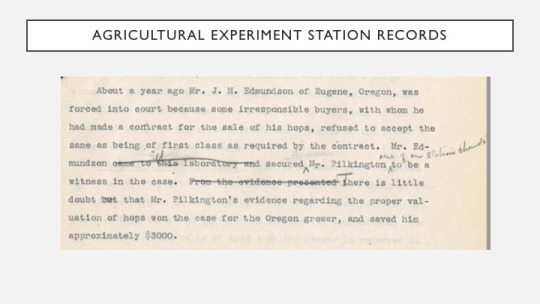
Fast forward to me working at a land grant university, running a brewing archive, looking at ag records. After over a decade in the archives profession I was accustomed to surprises. But I was still shocked to find this personal connection between Edmunson hops, Oregon Agricultural College, and Bert Pilkington, an Experiment Station hops chemist in the office correspondence from 1915 in the Agricultural Experiment Station Records.
The document referred to a 1914 court case involving John Edmunson, name spelled incorrectly with a second “d,” who was suing a buyer, Marcus J. Netter, for refusing a sale in 1912 because Netter claimed the hop quality was poor. Pilkington tested the hops and testified in court, saving Edmunson approximately $3000.
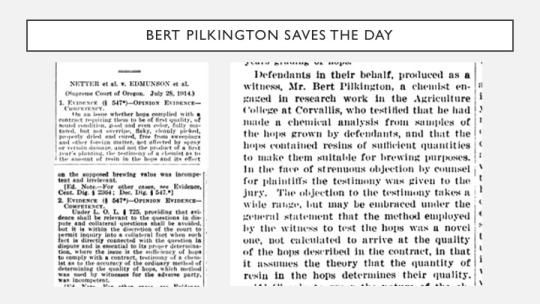
I did more research to fill in details about the case, because who could leave a mystery unexplored? I read Pilkington’s testimony in its entirety in The Pacific Reporter, a series of state Supreme Court decisions, including details about hop resin quantity, brewing potential, and the cleanliness of the Edmunson picking.

In addition to loving my job because it is really quite fun, I really value this personal connection to the land, my university, and this history.
The Agricultural Experiment Station Records at OSU are complemented by other collections produced by research units at the university, as well as other collections I’ve added since starting the archives in 2013. I’ve also been working with a beer history class for the past 3 terms and have a beer research guide that’s in perpetual beta.
1 note
·
View note
Text
What’s the story with the Hop Research Council? Glad you asked.
Blogging more? Processing more collections? What is going on in the Oregon Hops and Brewing Archives?!?!?! Two things: too many collections with too little description online and a promotion dossier that is nearly done (due Tues. Jan 22, currently in the “procrastinate by doing work bucket”).

Today I submitted the Hop Research Council Records guide for a final review, but since that guide is live I figured I would share the epic HRC history I just finished. It’s a Friday, dinner isn’t done, why not cut/paste?
The collection is three boxes of super interesting stuff. In addition to annual reports summarizing ongoing research projects funded by the HRC, the collection includes article reprints, bylaws, contracts, correspondence, financial records, meeting minutes, newspaper clippings, notes, research proposals, and symposium proceedings. Much of the research reflected in these records pertains to the development of new hop varieties and the management of hop diseases like powdery mildew. Because I live/work here I’ll do a shout out to projects by researchers in Corvallis, including those in the USDA-ARS; this includes the work of Alfred Haunold, Cindy Ocomb, Ward Strong, Max Deinzer, and John Henning.
So here it is -- enjoy!
The Hop Research Council (HRC) is an international organization, based in the United States. It was formed in 1979, with offices in Oregon, to fund hop research by soliciting and providing funds for scientific investigation and research related to the agricultural production of quality hops in the United States. Historically, funded projects have been in the areas of plant pathology, agronomic research, public hop breeding, a clean plant network, entomology, and brewing research. Furthermore, the HRC allows researchers to quickly direct attention to a specific area of research when new needs arise. HRC has distributed approximately $10 million in grant funds to hops research projects. Membership of the council is made up of representatives from the brewery industry, state hop commissions, and hop dealers. HRC serves the entire hop industry by supporting research that meets the needs of members, but they also work to facilitate communication between the council, brewers, growers, hop dealers, and the scientific community.
Public hop research had been supported by the United States Brewers Association from about 1950 through 1978. That year it lost a major member, and as a result of the associated revenue loss, programs discontinued technical activities, including the support of hop research. Although the USDA-ARS and the universities of Washington, Oregon, and Idaho could contribute facilities and modest budgets for personnel, the loss of United States Brewers Association funding was a severe blow to hop research in the United States. It was clear to many that an industry that provided a high-quality commodity to the domestic market and a competitive product with an annual export value of $51 million required research support in order to maintain its quality consciousness and competitive stance.
Believing that the hops and brewing industries could benefit from a united hop research effort, concerned brewers, dealers, grower organizations, and others met early in 1979 to form an organization designed to support hop research in the United States. The purpose was to explore ways to fund research that meets the demands of all segments of the industry. Present at the first meeting were representatives from Adolph Coors Co., Anheuser-Busch, Inc., California Hops Growers Association, George Segal Co., Idaho Hop Commission, John Barth Inc., John I. Haas Inc., L. Oppenheimer and Co., Lupofresh Inc., Olympia Brewing Co., Oregon Hop Commission, Pabst Brewing Co., Pfizer Inc., S.S. Steiner Inc., The Stroh Brewery Co., United States Hop Administrative Committee, Von Horst Co., Washington Hop Commission, and Washington State Hop Producers Association.
By the mid-1980s the scope of research supported included breeding and genetics at Washington State University and the USDA-ARS program at Oregon State University, insect and mite programs at WSU and the University of Idaho, disease control programs at WSU and OSU, and two chemistry programs at OSU, one supporting the breeding programs and the other concerning hop contributions to the aroma and flavor of beer. From the beginning, a special fund was identified to supporting special, short-term projects. During HRC’s first year about $73,000 was raised through pledges and distributed among the research programs. This does not mean that U.S. hop research is funded primarily by the HRC; the USDA-ARS provides a nucleus for research. Instead, the HRC serves as a focus for U.S. hop research and provides an important incentive for and demonstration of the importance of this activity.
The development and commercialization of new high alpha varieties afforded a competitive advantage for American hops grown for use at home and abroad; these included Galena, Eroica, Nugget, Olympic, and Chinook. Equally important was the development of aroma varieties, including the Willamette, Mount Hood, and Liberty. Additionally, in the 1980s, European varieties were evaluated for agronomic and brewing characteristics.
The HRC holds two annual meetings. The summer meeting includes a business session and a hop field day where experimental and commercial yards are inspected. The winter meeting includes a comprehensive review of the research HRC supports; each project leader provides a written report, which is assembled according to research category and distributed to members as a single bound booklet prior to the meeting. During the meeting, budget committee and the new proposals evaluation committee meet, and project leaders present their results and future plans. Each presentation is followed by a discussion, which provides interaction between the researcher and the brewers, dealers, growers, and others present; this ensures that every aspect of research has input from all phases of the industry.
#hop research council#oregon state university#hops history#hops research#oregon hops and brewing archives#hops#beer#oregon hops
3 notes
·
View notes
Text
January 31, 2020. The Widmer Brothers Brewing Company pick up.
Remember January 2020? 01_01_2020? A year that started out VERY fun until that special Friday the 13th in March when it wasn't.
On January 31, 2020, my co-worker Karl McCreary, collections archivist, and I made a trip to Portland in a very large white cargo van to pick up a collection. A very special and important collection.
Jeff Alworth, who had recently released his book The Widmer Way, had worked his way through many of these historic materials and gathered oral histories in the process. The company was at a point of transition and he knew these records needed to go somewhere. Fortunately, he also knew about the Oregon Hops and Brewing Archives!
It took two years to process, but I finished up reviewing, organizing, and describing the collection last month. 2 1/2 years after we picked this up... I've been an archivist for nearly 20 years, but the twists and turns of this collection slowed me down! Also, there was a pandemic.
I'll post the info about the final product of the collection in the next couple days, but for today I want to celebrate these pictures. They are a set of "on the cusp of something these two people didn't anticipate" pictures, which are touching as we've rounded the corner from January 2020 into August 2022.
January 2020: my daughter turned 16. August 2022: my daughter goes to college. Life goes fast. Stop to appreciate the model cars and wall paintings.
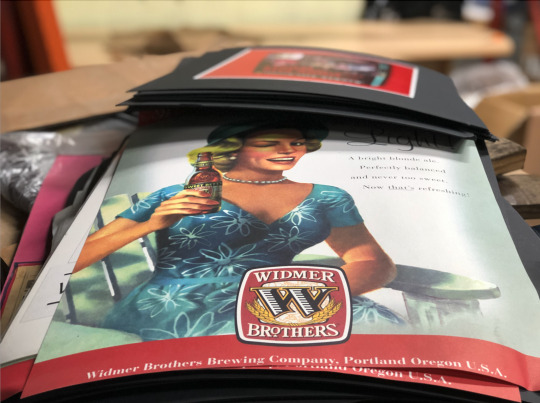


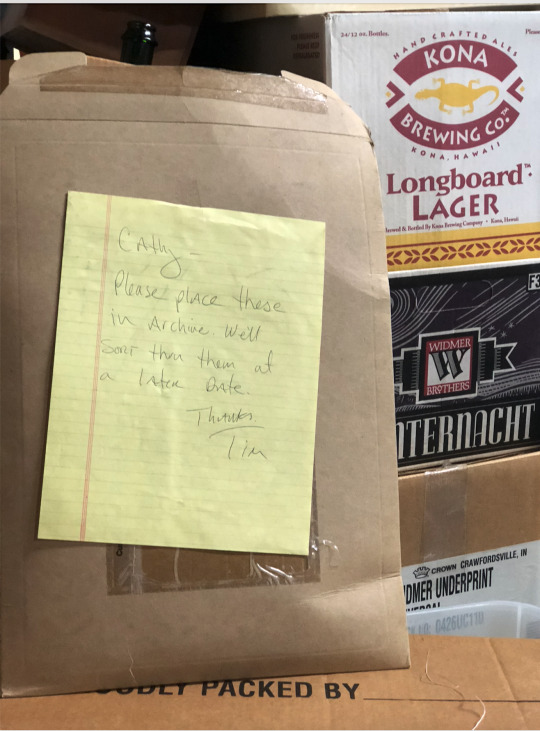





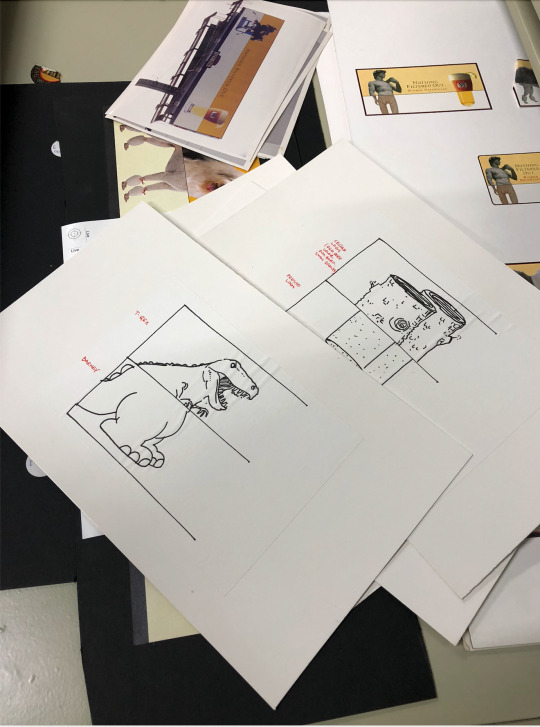



But wait, there's more!
Part 1: The Collection
Part 2: The Company
#widmer brothers brewing#oregon beer#beer history#oregon#widmer#oregon hops and brewing archives#jeff alworth#widmer archives
1 note
·
View note
Text
Collection Report: Rock Bottom Brewery Records, 1994-2010

Just before the 2020 shut down, Van Havig (co-owner / brewer at Gigantic) approached me at the Oregon Brewers Guild annual meeting and said he had 16 years of brewing records from Rock Bottom Brewery. He wanted to donate them to the Hops & Brewing Archives. Yay!
Then COVID...
In summer 2022, he drove two boxes of binders down to Corvallis and mere weeks later I had a guide for the collection done (nearly unheard of speed in archives, but it was perfectly organized and easy). It's a tidy one-box collection, but an interesting look at both standardization and creativity in a corporate brewery.
Rock Bottom Brewery Records, 1994-2010
Here's what's in the collection.
The Rock Bottom Brewery Records document the brewing operations at the SW Morrison Street, Portland, Oregon facility. Brew and kegging logs record data about ingredients, temperatures, waste, and other measurements of the brewing process and when the beer is in storage.
The earliest brewsheet in the collection is batch 11, Pelican Ale. The beers they made didn't change significantly in later years, but brewers were able to experiment with their own recipes and names. In the earliest years (1994-1995), the brewers made five standard recipes: Pelican, Coyote, Brown, Red, and Stout. The sheets in the "Portland Recipes" folder are undated recipes for the early brews. By 2004, they most frequently brewed IPA, Wheat, Amber, Porter, and Lager, but also made Stouts (Irish, Cream, Imperial, and Oat), Kolsch, and Oktoberfest. In 2014, they still brewed IPA, Wheat, Kolsch, but added Belgian, Honey Blonde, Orange Porter, and Rye Stout to their regular rotation.

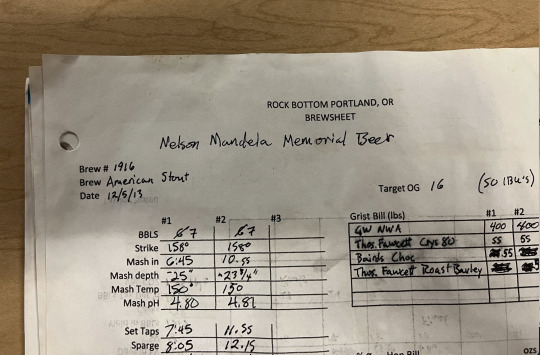
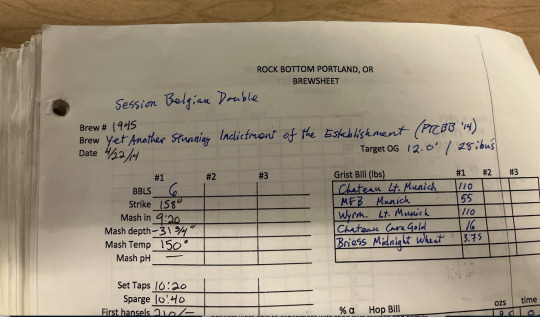


In 2014, they released a "Hipster Beer Series," which included beer names such as "Barley & Me," "Bull Run Red," "Yet Another Stunning Indictment of the Establishment" (a Session Belgian Double), and "Fight Hunger with Beer." Also in 2013 and 2014 were beers called "Yippie-Ki-P-A Motherf***ker," "No Ryegrets," "You'll Shoot Your Eye Out, Kid" (a Christmas Helles), "54 40 or Fight," and memorial beers dedicated to Maya Angelou and Nelson Mandela.
Here's some info about the brewery.
Rock Bottom Brewery is a Denver-based chain of brewpubs. They opened the Portland, Oregon pub in 1994 at 206 SW Morrison Street. It closed in 2019 after the landlord did not renew the lease on the restaurant. Brewers included Matt Sage, Van Havig, Charlie Hutchins, Bolt Minister, Scott Guckel, Pat O'Shea, and Todd Britt.
The chain was founded in 1991 in Denver and rapidly expanded in the 1990s, opening dozens of locations throughout the United States; at that time, businesses that brewed on-site and operated a full-service restaurant were unique. Every Rock Bottom has its own brewer and they could make their own beers based on local market taste. In 2010, Rock Bottom Brewery and Gordon Biersch Brewery were acquired by Centerbridge Capital Partners and merged to form the new CraftWorks Restaurants and Breweries. CraftWorks is based in Broomfield, Colorado.
1 note
·
View note
Text
5 years of OHBA...
August 1, 2013 we launched a brewing history archive.
Apart from some museum projects and corporate archives, there weren’t any others for me to look to or model this archive after. That’s okay, I’m from Oregon and we like to do things ourselves.
I had some great early advisors and campus connections. I have AMAZING colleagues who have given me their time, enthusiasm, and creativity. And I was also creating an archive in a place where it just made sense. We grow all the ingredients in Oregon, have an amazing research program at OSU, have some phenomenal large and small breweries, and have an engaged consumer community.
Over the past 5 years this project has grown and evolved in ways I never could have imagined -- even if I’d had someone to ask for guidance I doubt they could have given me an accurate roadmap!
I added 18 collections and conducted 100 oral histories; MADE A MOVIE!; tabled at festivals; presented at conferences; helped a lot of researchers on a lot of projects; driven all over our state and up into another one; and given countless talks at bars, retirement homes, and public libraries.
And then this summer there were so many people wanting to create similar programs to preserve and share this history that I formed the Brewing Records Consortium (you can join the FB group, keep watching for this page to be live, or direct message me for more).
But as I look back I admit that what feels SO amazing about these 5 years is knowing that I’ve met people I never would have met and had conversations I never would have had. I talk to people I have little in common with and I find common ground. We need so much more of that.
It’s never been all about the beer, though of course it is... It’s about working hard to save the story of industries (hops, barley, yeast, brewing, tourism, labor, et al) that have such a major impact on the fun we have, the places we work, and the way we tell the story of our regional identity.
What comes in the next 5 years? I’ve never been one to set concrete benchmarks for “success” or “growth,” so I’ll say that I want to continue to make connections, grow collections, and laugh with new & old friends.
I thank everyone who has given me their time and their stuff. I feel so lucky to have this archive be such a major part of the work I do everyday.
Cheers.

4 notes
·
View notes
Text
What can you find in an old newspaper?
When I’m not getting hailed on while weeding my front yard, I’ve been spending an awful lot of time in my corner chair looking through results in online newspaper databases.
This morning my husband looked over my shoulder and said "So what exactly are you looking for in those old papers?"
The real answer is “I don’t really know.” The answer I gave him was "clues."
Once upon a time you had few alternatives for doing newspaper research. Boxes of delicate papers or microfilm.

This was time consuming and place-based. You needed to know which newspaper to consult and you needed to go to a place with the paper or film and equipment. You also had to skim... look through many issues to find a mention of the business or person you were trying to find. Arduous, for sure.
But also rewarding because you got an amazing sense of the place and change over time. The issues a community is facing, the babies that were born, and the ads for products people buy. You’d find a clue in an ad, a name of a saloon manager, a small thread to pull in hopes that the name will come up again in the same city. In another city? In some way related to brewing?!?
When journal databases first came online we were delighted. I remember working on a paper for a Comedy/Tragedy Lit class when I was in college, and I was able to search for articles on a computer! In my apartment! It was amazing! But rather than getting full page duplicates, what we ended up with was the content of the article we found - no formatting, no context, no serendipity, no ads. This is sill the case for many academic articles in databases, but now there are digitization projects that are working to provide online access to the content and context - and it’s full text searchable!
For those who did newspaper research “in the olden days,” you know this has opened up a world of information. No more travels, no nausea from microfilm.
There are two main free online sites I use to do newspaper research:
Historic Oregon Newspapers
Chronicling America
Newspapers.com is a subscription site that people rave about, but I’ve never paid the fee to see.
These are amazing and robust sites, but not all newspapers have been digitized and not all years are included. It’s also worth noting that the full text searching isn’t perfect.
There are lots of ways you can use these online sites:
To find names of brewers if you know the brewery
To find names of breweries if you know the name of the owner
To find out if a brewery is written about or advertised in a town.
To find the location of a brewery.
To find out information about property assessments or tax payments.
To find out information about plans for a new business
To see the advertisements
To find out who was visiting whom or if someone stayed in a hotel.
But like all sites, there are problems too:
Not all dates are digitized
Not all names are spelled correctly
Sometimes names are too common
Sometimes women are named by heir husband’s name.
Sometimes women get remarried and use their new husband’s name.
Not all things I think are news are newsworthy
When you search for a brewery name you can get rows of hits for advertisements - see below, all ads.

But the thing is, these articles and ads give you clues and details about a life. The little bits that fill out the story of a person make for a good story, but also allow us to think about these people as people, who lived wonderful and complicated lives. These are noteworthy women who end up with their names on a list, or in a presentation, or in a book, but they were also individual people.
I have reflected on this a lot in my own work as an oral historian, and I feel very strongly that the work of an archivist, oral historian, and historian needs to move beyond dates to find the personal pieces that make up a life. We can make these women more than examples in the category of “women in brewing,” something I fear we now defaulted to in an effort to highlight women in the brewing industries. As if there was a static definition? Or as if there is a single “us versus them” narrative, a simple answer to the gender question, a shared set of values, a “monochrome” female subculture?
And as I reflect on my work to save and uncover the history of women in brewing -- pre-Prohibition through crafty Beervana -- in the end, I see it all intertwined in giving women their own voice, a chance to reflect on their own complicated and oftentimes contradictory experiences or observations. In present day that means we give them the power to their own story or record of their experiences. And then, hopefully, to have someone learn from them.
In the next post I'll share what I actually found.
All my clues from my old newspapers...
#historical research#beer research#beer history#oregon hops and brewing archives#women in brewing#history of women in brewing#prepinkboots
4 notes
·
View notes
Text
Collection report: Don Younger Beer Publications Collection, 1979-2007
Don Younger bought the Horse Brass Pub in Portland, Oregon in 1976. He was a strong supporter of local beer and a mentor for other publicans, and lucky for us he was also a collector!

Don Younger, circa 2005 * photograph by Lisa Morrison
A couple months ago I finished the guide for the Don Younger Beer Publications Collection, which is a terrific set of periodicals and newsletters collected by Younger about brewing in the United States.
https://bit.ly/mssdonyounger
Younger created indexes to articles and subject files as well; most are undated, but include article titles, correspondence and promotional materials, and information on companies and people.
Younger was a book and ephemera collector; though these materials were given to others after his death, this collection includes notable limited run publications such as Beer Travelers, Brass Tacks Horse Brass Pub newsletter, The Pint Post, and Alephenalia Beer News (published by Merchant du Vin). These newsletters include information about tastings, regional news, beer reviews, publications, and recipes.
These collection guides also have biographies of the person or organization that created the records -- mine are always really long!
Donald Allan Younger was born in San Francisco in 1941. The first bar he set foot in was the Howdy Doody in Gresham, Oregon. Though he was 17, he looked 13, snd he was served a Blitz beer anyway. He loved it. By the late 1960s, he was a regional office manager in Portland, Oregon for Lever Brothers, a consumer goods company that promoted brands like Lifebouy, Pepsodent, and Mrs. Butterworth’s. When his brother Bill returned from Vietnam and suggested they buy a tavern, Younger agreed. They opened the Mad Hatter tavern in Southeast Portland in 1967 and later Strawberry Fields in suburban Gresham. Rules for operating a tavern at that time were restrictive, with limitations on singing or dancing and ban on having windows or serving wine; when those were loosened, the clientele changed and brought different interests for food and drinks.
Younger’s acquisition of the Horse Brass Pub in 1976 is steeped in lore. The one most often told is that one afternoon while his car was being fixed he stopped at the “homey English-style pub” on Southeast Belmont Street, which sold pizza. He’d never been to the Horse Brass before, never drank anything besides light American lagers, and hadn’t visited the U.K. He and then-owner Jay Brandon drank a lot and, as legend has it, Younger awoke the next morning with the deed to the bar scribbled on a cocktail napkin in his pocket. It’s unclear if he won it in a poker game or just bought the place, but it is clear that his brother was surprised to co-own a new property.
In 1977, the Horse Brass began carrying bottles of New Albion, the first "microbrewery" in America in the post-Prohibition era, which was a stretch for the small Sonoma, California brewery. Younger was also excited by the opening of Portland’s Cartwright Brewery in 1979 because he looked forward to serving beer from a local microbrewery. In 1982, he put Grant’s from Yakima, Washington on tap, which was the first microbrewery beer he served that wasn't in bottles. He said that people in Portland were ready for good beer, all they needed was someone to make it. Soon, he served beers from Anchor Brewing and Sierra Nevada, both from California, and BridgePort Brewing and Widmer Brothers Brewing, which both opened in Portland in 1984. Younger was dedicated to finding ways to showcase the promising new breweries and often ended up being the first Portland account for the brewers now regarded as pioneers. He offered early breweries like McMenamins, Rogue, Deschutes, and Portland Brewing some of their first tap handles. Rogue Ales still makes Younger's Special Bitters, named for Don's favorite beer brand and in honor of his late brother. Beyond serving beers from different breweries, he also encouraged different styles; in 1983, the Horse Brass put in the first cask hand pump, which was likely the first cask-conditioned beer available in a U.S. bar after Prohibition.
He also offered a gathering place for people to share and consume both local and imported beers. It was at the Horse Brass that brewers came together to draft the 1985 Oregon Brewpub Bill, which allowed breweries to make and sell their own beer onsite. Younger also played a leading role the creation of Oregon Craft Beer Month to offer breweries who were left out of the Oregon Brewers Festival an opportunity to promote their products; organizers called it “Fringe Fest,” later known as Oregon Beer Week and then Oregon Craft Beer Month. He was a mentor for others running pubs in America, and publicans from across the country consulted him for advice; as a result, he became part of a group of bar owners who called themselves the Publican National Committee.
Younger helped his friend Joy Campbell start Belmont Station in a small space next door to the Horse Brass Pub, which was among the first “craft” beer stores in the country. Concerned they wouldn’t succeed just selling beer, Younger and Campbell also offered hard-to-find British foods and breweriana. He owned or co-owned several other businesses, including the Rose and Raindrop in Portland and Lovejoy’s on the Oregon Coast; there was also a “sister” pub in the U.K. called the Princess of Wales. Younger helped found Lompoc Brewing in 1996 in Portland and was co-owner of the three New Old Lompoc locations. He also lent money to Duane Sorenson, the Stumptown Coffee Roasters founder, who worked at Belmont Station for nine months in 1999.
When reflecting on the broader success of breweries in Portland, Younger often credited Mike McMenamin and Bill McCormick (McCormick & Schmick’s, Jakes) for promoting local beer and international styles in their businesses. McMenamins opened the first distributorship, purportedly to sell bottles for Cartwright Brewing; then he opened the Produce Row Café and the Fat Little Rooster bar in SE Portland, before opening the Hillsdale Pub. McCormick offered multiple taps of different beers; their prominence as a restaurant in Portland gave others selling a more diverse beer menu credibility.
Younger died in Portland Oregon on January 31, 2011 after a short illness.
0 notes